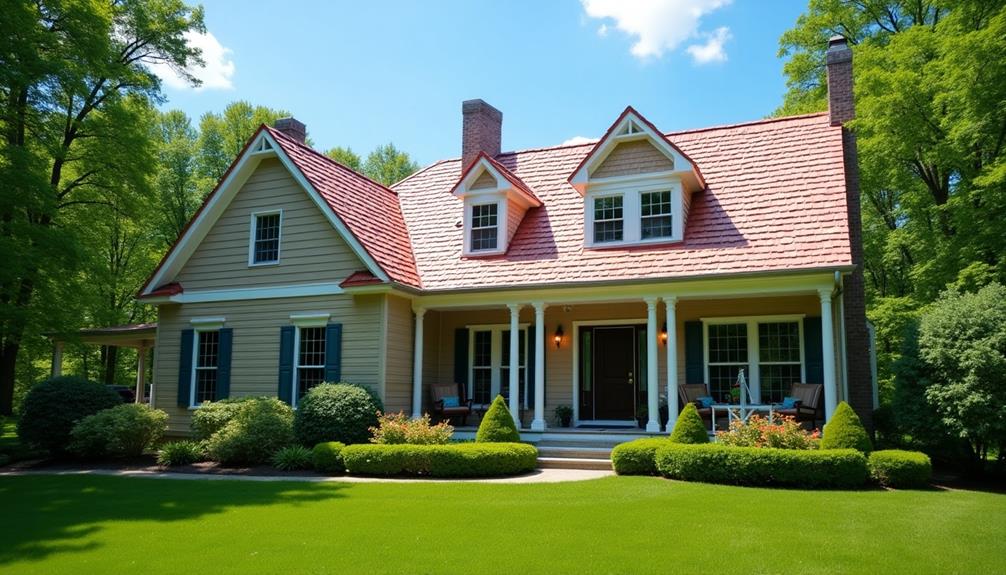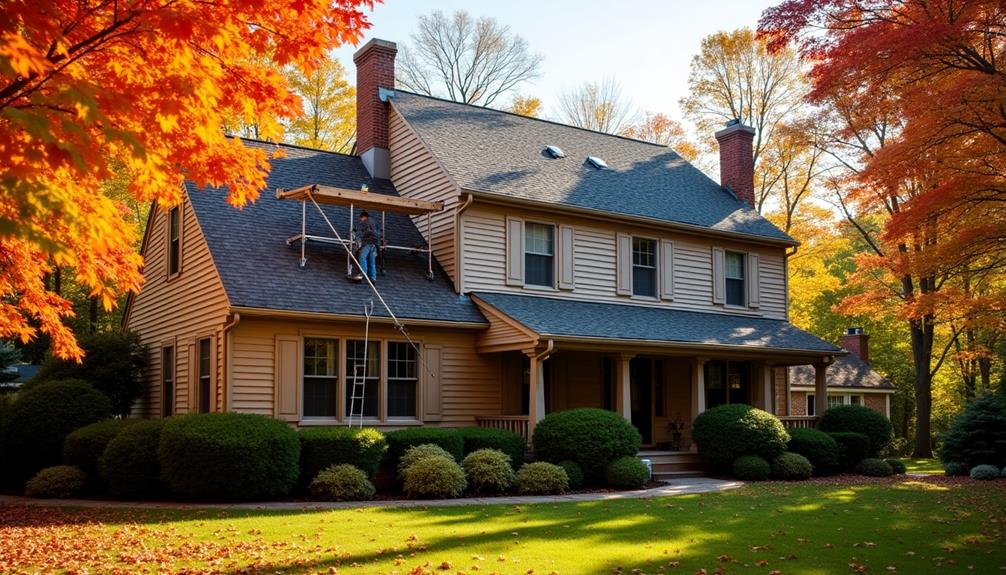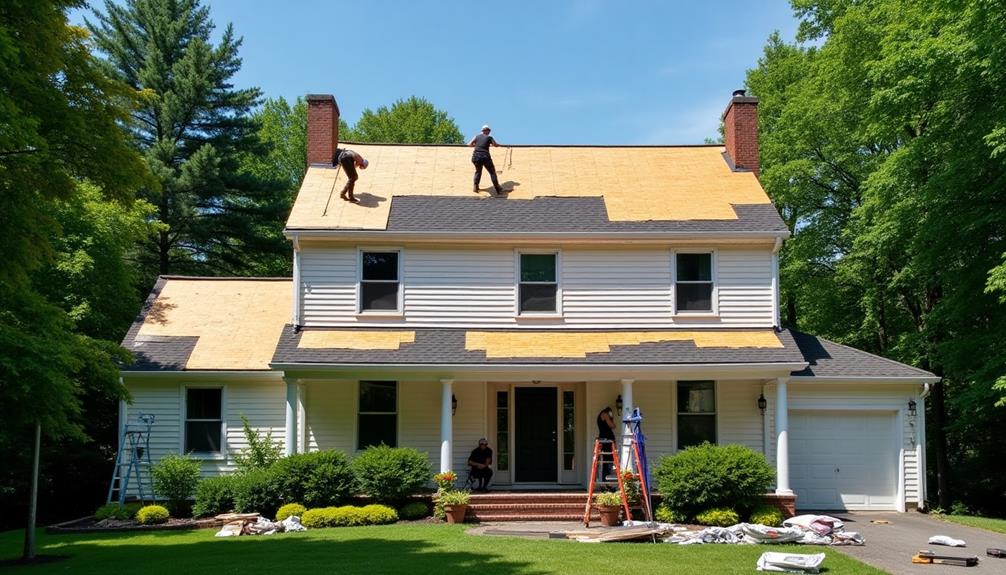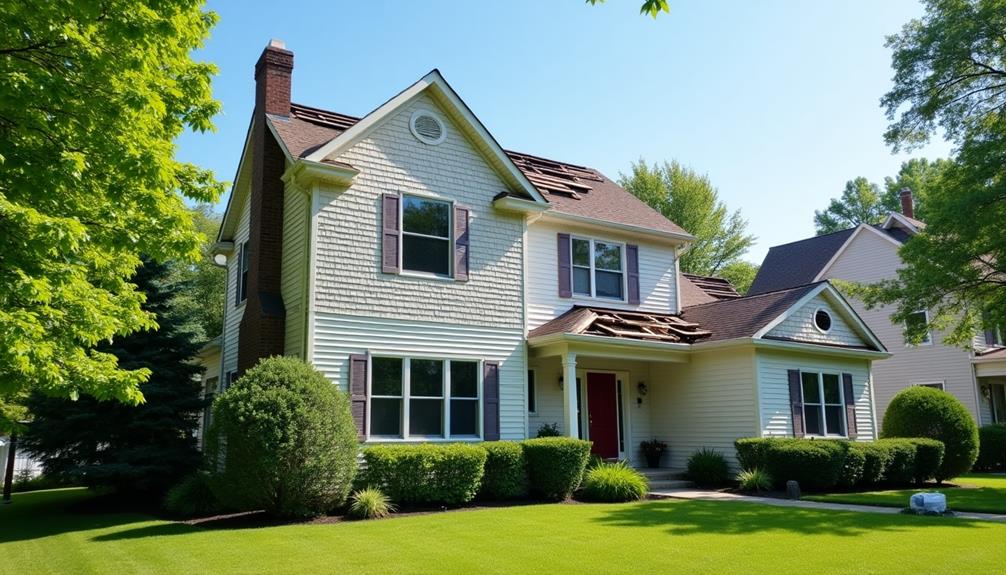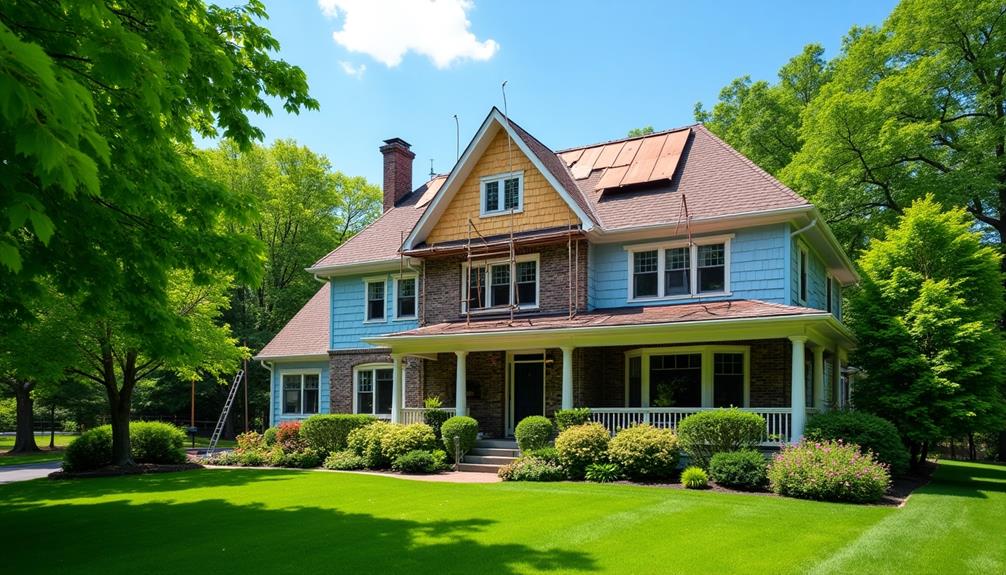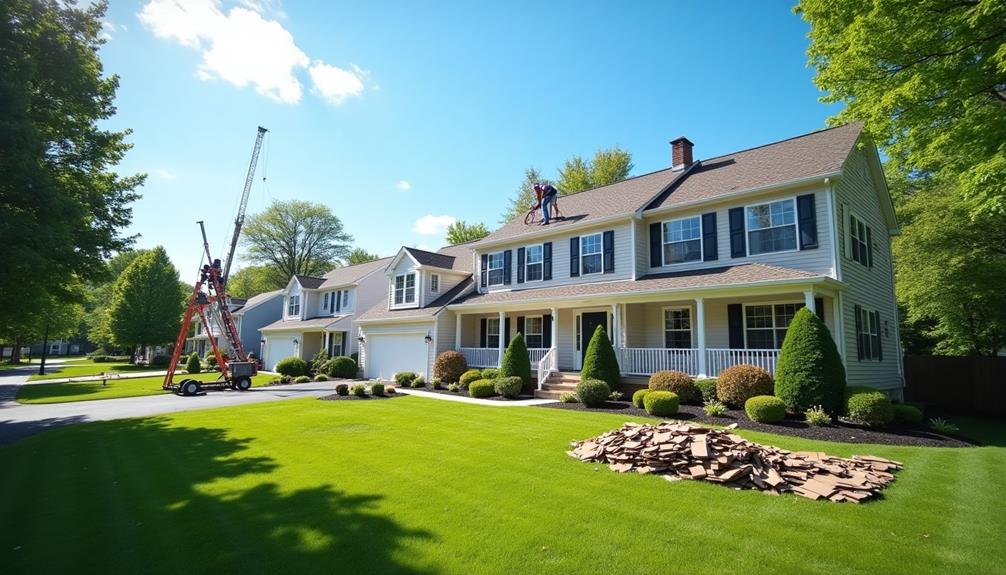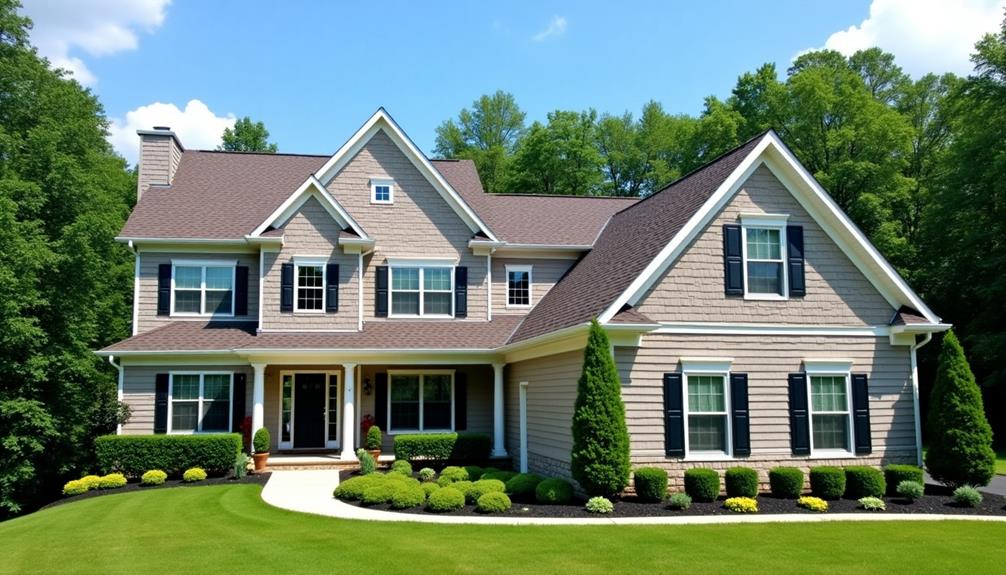When considering roof replacement in Deerfield Township, NJ, focus on key factors like materials, costs, and contractor selection. Inspect your current roof for signs of damage, such as leaks or sagging, and choose a material that fits your budget and longevity needs. Ensure you hire a qualified contractor familiar with local building codes to avoid fines. Factor in potential costs, including labor and permits, to avoid surprises. A new roof not only enhances your home's energy efficiency but also boosts its curb appeal. There's much more to explore about optimizing your roof replacement project effectively.
Importance of Roof Maintenance
Ensuring your roof remains in top condition is crucial for the overall health of your home. Regular maintenance directly impacts roof longevity, helping to prevent costly repairs or premature replacements. By following a well-structured maintenance checklist, you can easily keep your roof in optimal shape.
Start by inspecting your roof at least twice a year, ideally in spring and fall. Look for missing or damaged shingles, as these can lead to leaks if not addressed.
Clean out gutters and downspouts to ensure proper drainage, preventing water buildup that could damage your roof. Additionally, check for signs of moss or algae growth, which can compromise the integrity of roofing materials.
Don't forget to examine your attic for signs of water intrusion or poor ventilation, as these issues can affect your roof's lifespan.
Keeping trees trimmed back from your roof can also minimize debris accumulation and reduce the risk of branches damaging the surface.
Signs You Need a Replacement
Over time, your roof may exhibit several warning signs that indicate it's time for a replacement. One of the most critical signs is a leaking roof; water stains on your ceiling or walls signal underlying issues.
If you notice a sagging structure, this could indicate severe damage that requires immediate attention.
Inspect your roof for missing shingles or dark stains. Missing shingles expose your roof to further deterioration, while dark stains often suggest mold issues or water damage.
Additionally, if you see moss growth, it can trap moisture and lead to more extensive damage.
Consider the age factor of your roof. Most roofs last around 20 years, so if yours is approaching that threshold, it's wise to evaluate its condition.
Poor ventilation can also lead to energy loss, driving up your utility bills and stressing your roofing materials.
Types of Roofing Materials
When it comes time for a roof replacement, choosing the right roofing material is just as important as recognizing the signs that you need one. Various options are available, each with its own benefits and drawbacks.
Asphalt shingles are a popular choice due to their affordability and ease of installation. They've also adapted to roofing trends, providing options that mimic the look of more expensive materials.
Metal roofing is another durable option, known for its longevity and resistance to extreme weather conditions. It's lightweight, making it easier to install, and it can be recycled at the end of its life cycle, which appeals to environmentally conscious homeowners.
If you're looking for something with high material durability, consider slate or tile roofs. While more expensive upfront, they offer remarkable longevity and can enhance your home's value.
Choosing the Right Contractor
Selecting the right contractor for your roof replacement is crucial to ensuring a successful project. Start by evaluating contractor qualifications, as this will help you gauge their experience and reliability. Look for certifications, licenses, and insurance coverage that protect both you and the contractor in case of accidents or damages.
Next, ask for references and check customer reviews online. Positive feedback from previous clients can provide insight into a contractor's work quality, punctuality, and professionalism. Pay attention to any recurring themes in reviews, as they can highlight strengths or weaknesses in the contractor's service.
It's also wise to obtain multiple estimates. This not only gives you a range of pricing options but also allows you to compare the scope of work proposed by different contractors.
Be cautious of bids that seem too low; they may indicate subpar materials or hidden costs.
Local Building Codes
When replacing your roof in Deerfield Township, you need to be aware of the local building codes, which include specific permit requirements.
Ensuring compliance with these regulations not only keeps your project on track but also guarantees adherence to safety standards.
Understanding these codes will help you avoid potential fines and ensure a successful roofing project.
Permit Requirements Overview
Obtaining the necessary permits for a roof replacement in Deerfield Township, NJ, is crucial to ensure compliance with local building codes. Before you begin your project, familiarize yourself with the permit application process and zoning regulations that may apply to your property. This ensures that your roof replacement meets all local requirements.
Here's a quick overview of the permit requirements:
| Requirement | Details |
|---|---|
| Permit Application | Submit your application to the local office. |
| Zoning Regulations | Confirm your project adheres to local zoning laws. |
| Inspections Required | Schedule inspections before and after the project. |
| Documentation Needed | Provide structural plans and previous permits if applicable. |
Compliance With Safety Standards
Ensuring compliance with local building codes is essential for a successful roof replacement in Deerfield Township, NJ. These codes are designed to protect your property and ensure the safety of your family. Understanding and adhering to safety regulations is a critical part of the roofing process.
You'll want to familiarize yourself with the specific codes that pertain to your project, as they can vary depending on your home's location and the materials used.
Before starting your roof replacement, it's crucial to obtain the necessary permits and schedule inspections. Following proper inspection protocols not only keeps you compliant but also helps identify potential issues early on, saving you time and money in the long run.
During the project, ensure that your roofing contractor is well-versed in local safety regulations. They should use appropriate materials and installation techniques that meet or exceed these standards.
Regular communication with your contractor can help ensure all aspects of your project remain compliant. By prioritizing adherence to local building codes, you'll not only enhance the safety and durability of your new roof but also protect your investment for years to come.
Weather Considerations
How do weather conditions impact your roof replacement project in Deerfield Township, NJ? Understanding the seasonal impacts and climate resilience is crucial for successful roofing. The timing of your project can significantly influence material performance and installation efficiency.
Here's a breakdown of how different weather conditions affect roof replacement:
| Weather Condition | Impact on Project | Recommended Action |
|---|---|---|
| Rain | Delays installation; risk of leaks | Schedule during dry spells |
| Snow | Increased weight; safety hazards | Avoid winter months |
| High Temperatures | Adhesive issues; material expansion | Work in cooler parts of the day |
| Wind | Safety concerns; debris | Monitor forecasts; delay if necessary |
| Humidity | Longer drying time for materials | Choose materials suited for moisture |
Being proactive about these factors can enhance the longevity and effectiveness of your new roof. By considering the weather, you're not just getting a new roof; you're investing in a durable solution that can withstand Deerfield Township's climate challenges. Always consult with your roofing contractor to ensure they factor in local weather patterns during planning.
Cost Factors to Consider
When planning your roof replacement in Deerfield Township, it's essential to consider how your choice of materials will impact overall costs.
Different materials come with varying price points and durability, which can significantly affect your budget.
Additionally, labor expenses should be factored in, as skilled installation can influence both the quality and longevity of your new roof.
Material Choices Impact Cost
Choosing the right roofing material can significantly influence your overall replacement costs in Deerfield Township, NJ. The materials you select won't only impact your budget but also affect the long-term value and sustainability of your home.
Options such as asphalt shingles, metal roofing, and slate all come with varying price points and durability ratings.
If you're considering sustainable materials, you might find that choices like metal or certain types of tiles can be more cost-effective over time due to their longevity and energy efficiency. These materials may have a higher upfront cost but can save you money on repairs and energy bills in the long run.
Aesthetic preferences also play a crucial role in material selection. While you may be drawn to the classic look of wood shakes, keep in mind that they require more maintenance and can drive up costs.
On the other hand, modern materials offer a variety of styles that can enhance your home's curb appeal while remaining within your budget.
Ultimately, balancing your aesthetic desires with practical considerations will help you make an informed decision that suits both your taste and financial situation.
Labor Expenses Overview
While selecting the right roofing materials is vital, understanding labor expenses is equally important in determining the total cost of your roof replacement in Deerfield Township, NJ. Labor costs can significantly impact your budget, and several factors contribute to these expenses.
First, labor market trends play a crucial role in shaping costs. In periods of high demand, you might notice increased pricing due to a shortage of available workers. Conversely, in a slow market, you could find more competitive rates.
Next, consider the complexity of your roofing project. More intricate designs or repairs may require a skilled workforce, which can further drive up labor costs. Hiring experienced professionals ensures quality workmanship, but it typically comes at a premium.
It's also essential to account for the time frame of the project. Longer projects incur additional labor fees, so having a clear timeline can help you manage costs effectively.
Energy Efficiency Benefits
Investing in a roof replacement not only enhances your home's curb appeal but also significantly boosts its energy efficiency. A new roof, especially one designed with modern materials, can provide substantial energy savings. Advanced roofing technologies, such as reflective coatings and energy-efficient shingles, help to reduce heat absorption, keeping your home cooler in the summer and minimizing the workload on your HVAC system.
Additionally, roof replacement often includes insulation improvements. Upgrading your insulation can drastically enhance your home's thermal performance, reducing heat loss in the winter and preventing cool air from escaping in the summer. This means you'll spend less on heating and cooling, leading to lower energy bills over time.
Moreover, improved ventilation systems can accompany your new roof, further optimizing your home's energy efficiency. Proper ventilation helps regulate indoor temperatures and moisture levels, contributing to a healthier living environment.
Preparing for Installation
Before your new roof installation begins, it's essential to prepare your home and property to ensure a smooth process. Proper site preparation is key to minimizing disruptions during the project.
Start by clearing the area around your home, removing any outdoor furniture, planters, or decorations that might obstruct the installation. This not only protects your belongings but also provides the crew with easy access to your roof.
Next, consider notifying your neighbors about the upcoming work. They'll appreciate the heads-up regarding potential noise and activity, and it can help maintain good relations during the project timeline.
If you have pets, make arrangements to keep them indoors or away from the work area to ensure their safety and comfort.
Additionally, it's wise to check your home's interior for items that might be affected by vibrations or debris. Move any valuables and delicate items away from walls that run parallel to the roof structure.
Following these steps will streamline the installation process and help your contractor work efficiently. Ultimately, being proactive in your preparation will lead to a successful roof replacement experience.
Post-Replacement Care Tips
After replacing your roof, maintaining its integrity is crucial for longevity.
Establish a regular inspection schedule to identify potential issues early, ensure proper drainage to prevent water damage, and clean your gutters frequently to avoid clogs.
These proactive measures will help you protect your investment and keep your roof in optimal condition.
Regular Inspection Schedule
To keep your new roof in optimal condition, establishing a regular inspection schedule is essential. Seasonal inspections, ideally conducted in spring and fall, allow you to identify potential issues before they escalate.
During these inspections, use an inspection checklist to ensure you cover all critical areas, including shingles, flashing, gutters, and ventilation systems.
Start by checking for damaged or missing shingles, as these can lead to leaks and further deterioration. Next, inspect the flashing around chimneys and vents for any signs of rust or gaps.
Pay close attention to your gutters; they should be free of debris to ensure proper water flow. Additionally, look for any signs of mold or moss growth, which can indicate moisture retention.
Don't forget to evaluate your attic's ventilation and insulation. Proper airflow helps prevent heat buildup, reducing the risk of damage to your roof structure.
By adhering to a regular inspection schedule and utilizing an inspection checklist, you can maintain your roof's integrity and longevity, minimizing the risk of costly repairs down the line.
Regular attention won't only protect your investment but also enhance your home's overall efficiency.
Proper Drainage Maintenance
Maintaining proper drainage is vital for the longevity of your new roof, especially after replacement. Effective drainage systems are crucial to managing water flow off your roof, preventing water pooling, and reducing the risk of leaks and structural damage.
To ensure your drainage systems function optimally, regularly check for any blockages caused by debris, leaves, or other materials. These obstructions can impede water flow and lead to overflow, which may damage your new roof and underlying structures.
Make sure that downspouts direct water away from your foundation to prevent soil erosion and water damage.
Additionally, inspect the roof's slope to ensure it promotes proper water flow toward the drainage systems. If you notice any areas where water tends to accumulate, it might be wise to consult a professional to discuss possible adjustments.
Lastly, consider the installation of additional drainage solutions if your property frequently experiences heavy rainfall or runoff.
Clean Gutters Frequently
Cleaning your gutters frequently is essential for safeguarding your newly replaced roof. Clogged gutters can lead to water overflow, which may damage your roof, fascia, and even your home's foundation. To ensure optimal performance, schedule regular gutter cleaning sessions at least twice a year, ideally in spring and fall.
During gutter cleaning, focus on thorough debris removal. Leaves, twigs, and other materials can accumulate and block water flow. This blockage can create a breeding ground for pests and increase the risk of ice dams during winter.
If you're comfortable, use a sturdy ladder to access the gutters, or hire a professional for safer and more efficient cleaning.
Additionally, consider installing gutter guards to minimize debris buildup. These guards can help reduce the frequency of gutter cleaning while still allowing water to flow freely.
Remember to inspect your gutters after heavy storms to check for any signs of damage or blockage, as quick action can prevent costly repairs later on.

